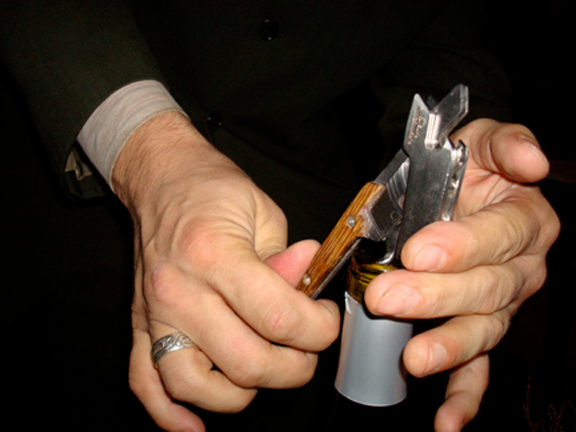From the department of “nice work if you can get it”…
 Above: my friend and client Tony Vallone’s foie gras torchon with “pear cracklings,” crispy pear skins.
Above: my friend and client Tony Vallone’s foie gras torchon with “pear cracklings,” crispy pear skins.
Last night found me a guest of my friend and client Tony Vallone at his flagship Tony’s for a wine dinner featuring the wines of Morlet Family Vineyards.
After reading up his California estate, I was impressed by the glowing praise and the across-the-board astronomic scores the wines have received from all sides of the wine writing establishment.
Robert Parker, Jr. has called him a “genius.” Honestly, that doesn’t really score a lot of points with me personally. But then when I saw that Antonio Galloni also wrote about Luc’s wines with superlatives like “off the charts” and scores to match, I began to inuit that Morlet has resonated broadly with the California wine intelligentsia.
I’d tasted a few of Luc Morlet’s wines previously at Tony’s but I had never tasted his top wines and I was very curious meet Luc and taste with him.
 Above: Luc’s Sonoma Coast Chardonnay Ma Douce illustrated his deft hand at barrel fermentation and barrel aging. He talked at length about the importance of not filtering. This isn’t a wine that I can afford but I thought it was gorgeous and enjoyed it immensely. Parker called a previous vintage “staggering.”
Above: Luc’s Sonoma Coast Chardonnay Ma Douce illustrated his deft hand at barrel fermentation and barrel aging. He talked at length about the importance of not filtering. This isn’t a wine that I can afford but I thought it was gorgeous and enjoyed it immensely. Parker called a previous vintage “staggering.”
Luc, who was born and raised in Champagne, where his family continues to produce barrel-fermented wines, didn’t seem keen to talk about the fact that he is one of the premier cooperage brokers in California today. Understandably, he wanted to keep the focus on his wines and he wanted to connect with the well-heeled crowd that gathers at Tony’s for dinners like this.
But it’s abundantly clear that his experience in Europe and his expertise in cooperage has set a high new bar for the use of barriques in California, where, historically, winemakers have often favored oakiness in their wines.
Luc’s Sonoma Chardonnay Ma Douce and his Sonoma Coast Pinot Noir Côteaux Nobles were both fantastic. And they perfectly illustrated how restrained, thoughtful use of oak can deliver wonderful balance and extreme elegance. I liked the wines a lot.
(Luc will be speaking about cooperage and pouring barrel samples today at the Houston Sommelier Association, btw. It should be a fascinating tasting and he’s a great speaker.)
 Above: Tony and his chef Kate McLean are geeked about the Crescent Island duck they’ve been serving at the restaurant. I loved its balance of gentle fattiness and earthy flavor. It was a great pairing for Luc’s Knights Valley Cabernet Sauvignon Mon Chevalier.
Above: Tony and his chef Kate McLean are geeked about the Crescent Island duck they’ve been serving at the restaurant. I loved its balance of gentle fattiness and earthy flavor. It was a great pairing for Luc’s Knights Valley Cabernet Sauvignon Mon Chevalier.
In the short time I got to speak with Luc intimately, he was eager to talk to me about the Knights Valley AVA where he is growing Cabernet Sauvignon.
It lies in between Napa and Sonoma and the community there has resisted heavy investment in viticulture.
But there are a few growers who have planted to vine there and Luc is one of them.
It’s on the west side of Mt. Saint Helena, he explained, the highest peak in the area, and so it has the ideal elevation and temperature variation for the cultivation of Bordeaux grapes.
I liked the Knights Valley Cabernet Sauvignon Mon Chevalier a lot but I think the wine will benefit from more bottle aging. Here the oak was evident and not yet entirely integrated into the wine, which is from Luc’s 2011 harvest. I hope I’ll have a chance to revisit it in a few years: with great acidity and earnest, classic Cabernet Sauvignon flavors, there’s no doubt this wine will represent yet another great effort from Luc’s cellar.
As he talked to me about Knights Valley, I became more and more convinced that Luc and his approach to winemaking could very well be the future of high-end wine in California.
Whether he’s raising wine in a little known appellation tucked between Napa and Sonoma or whether he’s illustrating the expert application of cask fermentation and aging, he seems always to be one step ahead of his contemporaries.
As the “new California” has begun to reshape the viticultural landscape there, Luc and his “old world” sensibilities align nearly seamlessly with the tastes of current-generation collectors and winemakers.
Very interesting wines. I just wish I could afford them!
 Click here to check out my notes from the super fun Franciacorta tasting I led this week in Austin.
Click here to check out my notes from the super fun Franciacorta tasting I led this week in Austin. Giacomo Mastretta (above) from La Porta di Vertine, my client, and one of the grooviest growers and winemakers in Chianti Classico will be pouring and speaking about the wines.
Giacomo Mastretta (above) from La Porta di Vertine, my client, and one of the grooviest growers and winemakers in Chianti Classico will be pouring and speaking about the wines.















